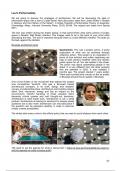Les 9: Performativity
We are going to discuss the strategies of architecture. We will be discussing the idea of
reformative space with a text of Judith Butler. Next discussion starts from Judith Butler's “Bodies
in Alliance and the Politics of the Street”, in Notes Towards a Performative Theory of Assembly
(Cambridge, Mass.: Harvard University Press, 2015), 66-98. The original text dates from Spring
2011.
The text was written during the Arabic spring. In that period there were same actions of public
space in Madrid, Wall Street, Istanbul. This images need to be in the back of your mind while
discussing this text. The text is important because there is a total di erent mindset. The state as
the bad, against the dictator.
Brussels architecture prize
Openstreets: This was a project action. A joyful
exploration of what can be achieved through
collective action. This project is an inspiration in
terms of how activism and public organizing can
help to both achieve healthier cities and reclaim
public space for all. You see bodies in the street.
The action was about assembling people in the
street. It is very di erent from the other projects
that are selected in 2023. It was installed 2
months ago. The project started 7 years earlier.
There was a protest and a study on the air quality
in Brussels around the air quality in Brussels.
One of the nders of the movement that started this project
was Annekatrien Verdicht. She gas a Brussels based
architectural company. In its work, design and research
occupy a fundamental place. Architecture and building require
e ort, time, resources, energy and has an impact on the
environment. Careful handling of these valuable items
demands critical queries and well thought-out decisions.
Architecture is tailor-made work. Architecture is not a serial
product. Architecture is looking for solutions for sharply posed
questions but is also more: architecture can only take place if
the question can be analysed carefully, in order to discover
initially unseen possibilities.
The whites dots were a wink to the o cial policy that we need to social distance from each-other.
‘We need to set the agenda for what is being built’ ( https://a-plus.be/nl/actualiteit/we-need-to-
set-the-agenda-for-what-is-being-built/)
27
ff fi ff ffi ff
, Intertwining urban ecology: The project
combines vision and persistence in an
outstanding way. Social housing is
introduced to complete a heterogeneous
urban fabric, accumulating their powers to
open a shared green core that is o ered to
the city’s inhabitants as a new public
sphere. Overcoming invisible boundaries
of responsibilities, this project shows how
designing from the potentials of the space
with a vision can open up new
opportunities for the city
Ixelles highline: Bringing continuity to a fractured
site, the project o ers a rich interplay between
infrastructure and public space, framing new
pathways for pedestrians
Junction urban park: A layered project of
great intricacy that connects the various
levels of a complex site. Creating
continuity between public space,
productive spaces and playground, the
project celebrates a disregarded
neighbourhood, showing the
transformative capacity of good design
and care
Park Pannenhuis: The park connects existing
park areas on a former railway site with
surrounding urban fabrics while creating a distinct
atmosphere of soft green abundance. It is
extremely carefully designed, dealing with di cult
height di erences and turning those into spatial
opportunities of joy and future commonality. The
decision to radically start from the existing is as
simple as it is exemplary and this represents an
important shift of attitude in design.
28
ff ff ff ffi




